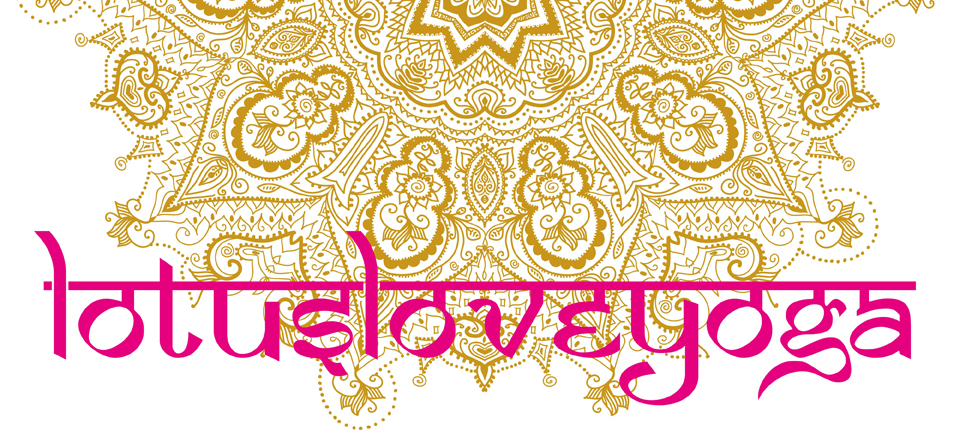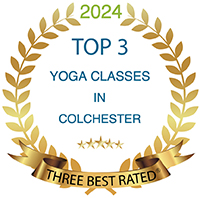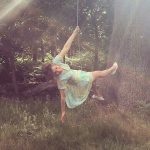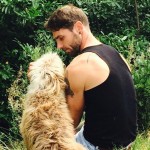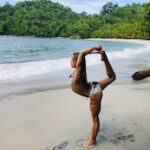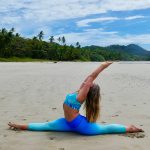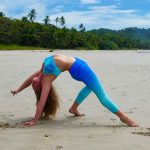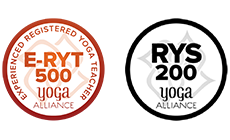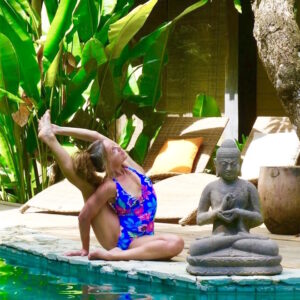
I have recently completed a Yin Yoga Teacher Training and I wanted to share some of the insights I have learned on my Yin Yoga journey.
Meridians – Pranamaya Kosha
For thousands of years, Taoism has taught the essential source essence of all life is wu chi. This is synonymous with the Sanskrit term prana, ki in Japanese or lung in Tibetan. Chinese medicine is based on the concept of chi as the dynamic source energy of creation. These ancient wisdom traditions discovered that chi flows through the body in an intricate network of energetic pathways called meridians. The meridian channels are housed in our deep connective tissues, passing through our visceral organs and vital energy centres. In opening the meridian pathways, we increase the flow of chi that nourishes the tissues and organs of the body; amplifies our energy and enhances our capacity to absorb more chi.
The inner body, bones, ligaments, connective tissues and lower limbs are considered yin aspects to our being because these are closer to the earth and more deeply hidden. Yin organs are those concerned with pure energy such as chi, blood, essence (jing) and spirit (shen). Yin organs transform, regulate and store vital energy: kidneys, liver, spleen, heart, lungs. There are corresponding meridians for each yin organ that ascend from the feet towards the head.
The superficial body, fascia, muscles, skin and upper limbs are considered yang because these aspects are closer to the sky and more perceptible. The yang organs are involved with impure substances such as absorbing and digesting food and waste: urinary bladder, gallbladder, stomach, small and large intestines. There are corresponding meridians for each yang organ that descend from the head towards the feet.
On our Yin Yoga training, we explored yin-yang organ pairs and corresponding meridian lines through yin yoga sequences. Sarah Lo clarified that yin yoga shapes are intended to be taught from a functional perspective so that target meridian-organs, joint sites, bones, ligaments and tissues are accessed through the practice. We are not creating an aesthetic yin yoga pose: we are allowing all bodies of any skeletal variation to experience yin yoga shapes with the functional intention to release the flow of healthy chi through specific acupressure points on meridian-organ lines so that our vital energy is neither stagnant nor distorted.
I imagined that three minutes in one position would feel like a long time; however, my experience was that the yin yoga pose became timeless. The parasympathetic relaxation response released through my body-mind and I felt wonderfully relaxed and spacious in the yoga shapes. We were invited to experience the rebound of chi in the target area after each posture. I experienced a body sensation of coolness releasing from my hip joints and a mind sensation of calm tranquility.
Yin Yoga is a personal journey of discovery that reveals unknown areas of light and dark, holding and releasing. It is wonderfully empowering to know that there is a practice that enables you to elevate your body-organs, mind-emotions, spirit-shen to wellness and that this innate vital health lies within you.
Resource: Insight Yoga by Sarah Powers
Anatomy – Annamaya Kosha
Our Yin Yoga training explored skeletal variations in the hips, pelvis and femur bones. This learning was consolidated by Paul Grilley’s presentation: ‘Bare Bones of Anatomy’. Skeletal bones and range of motion is unique to every-body and individual uniqueness is the beauty of the human form.
The hip sockets are different in every pelvis and this expresses in the student’s yoga practice. Adduction (moving away from the midline) and abduction (moving towards the midline) can be inhibited by the size of the femur bone in relation to the size of the acetabulum. Whilst muscular resistance can be released, bone to bone compression cannot be softened or lengthened.
The angle of hip socket orientation will also affect how a student practices yoga postures such as Butterfly Pose (abduction) because the femur bone draws back and down in the acetabulum and this causes compression. The yoga student’s limited range of motion is not necessarily due to muscular and fascial tension.
The shaft, neck and head of femur bone inclination varies student to student. Postures that abduct and externally rotate the legs, such as Dragonfly Pose, the neck of the femur compresses against the back of the acetabulum. It’s not necessarily the adductor muscles or hamstrings that are causing the restriction or compression.
Similarly, when the shoulder is in flexion, such as Quarter Dog Pose, the humerus bone compresses within the glenohumeral joint and acromian process, inhibiting range of motion in the shoulder joint. In the lumbar spine, the space between the spinous process indicates your range of motion in a back bend, such as Sphinx or Seal Poss. Once the spinous processes compress together, the lumbar spinal extension range of motion ends. If there is compression within the bones of the body, we cannot create space through muscular or fascial release.
Paul Grilley makes the essential point that postures should be built outwards from the spine; from the hip socket down and the shoulder socket out. Building the architecture of a pose from the feet up may cause distress on the joints above, therefore alignment becomes less important the further you move from the spine.
This knowledge and experience has shifted my perspective as a teacher and practitioner of yoga. I am predominantly a vinyasa flow yoga teacher and my classes focus on precise alignment of classical asana. I also have an appreciation for beautiful aesthetic yoga choreography and performance of the ‘perfect pose’. As a result of this training, I believe that I will be more emphatic yoga teacher and encourage students to find their own place and space within a pose through compassionate personal inquiry and discovery. I will be less inclined to adjust and assist bodies to fit a specific aesthetic form or shape. I believe this will be an empowering journey for those students who are inhibited by skeletal variations, yet feel defeated by the image of the ‘perfect pose’. This shift in my perspective reflects a more gentle yin approach to teaching a yang form of yoga.
I really enjoyed exploring the many variations of yin yoga shapes that compassionately create space for any-body to experience, such as Swan and Deer Pose variations. It was an interesting exploration of my own body in yin yoga shapes, cultivating compassionate acceptance through practice. Yin Yoga offers infinite possibilities for a range of skeletal variations and this creates a truly inclusive practice.
Resource: Bare Bones of Anatomy by Paul Grilley
Mindfulness – Anandamaya Kosha
Mindfulness has its roots in the ancient teachings of the Buddha and the Noble Eightfold Path. The Buddha describes that the universal desire of all beings is happiness and that our pursuit of this experience determines the quality of our lives. He explains that human beings are caught in the struggle between the dharma of pleasure and pain. Yet, we must seek an authentic happiness that is inclusive of all life experiences.
This authentic happiness is the journey of mindfulness.
The Buddha shared Three Jewels that support us on this path. We must cultivate the buddha-nature of awareness within us through mindful meditative practices. We cultivate a spacious presence that allows us to perceive life’s experiences from the nature of being and to see in a special way. The teachings of the Buddha are the dharma that guide us to recognise and stabilise our inner ground and path of awareness. The sangha is the community of people who walk this mindful path together.
The Buddha describes Four Noble Truths that are universally true for all human beings. He believed that suffering is an integral part of life. Whether you are a prince or pauper, all beings inevitably grow old and die. Because many people are unawakened to the buddha-nature of deeper being, they grasp to objects, people, habits and thoughts that are transient and impermanent, leading to greater experience of suffering. The Buddha also believed that human beings are able to cease grasping to that which they cannot possess and come to know the freedom of awareness that lies within. The Buddha offered the tools to experience true happiness and freedom from suffering in the Noble Eightfold Path. It is considered noble because the buddha-nature is our true inheritance.
The Noble Eightfold Path is composed teachings and practices that directly influence our behaviour: wise view, wise thought, wise speech, wise action, wise livelihood, wise effort, wise mindfulness. The Buddha emphasised the importance of mindfulness. This practice brings us into direct relationship with the roots of suffering, our pattern of reactivity and insight into our wisdom nature. We are able to perceive into the changing nature and impermanence of this world: anicca. We are able to recognise that our attachment to the fundamental flux of life inevitably leads to dissatisfaction: dukkha. Through the practice of mindfulness, we come to realise the vast awareness that is the only true permanence in this world: anatta and that this is our own true nature.
There are four foundations of mindfulness: mindfulness of the body, emotions, mind, the external world. On our Yin Yoga training, we experienced the practice of shamatha which means ‘tranquility of mind’ or ‘calm abidance’. This is a wonderful way to arrive and centre into steadiness through mindful observance of the breath. This simple yet effective technique settles the mind into stillness that is the nature of Being. Shamatha is an impactful practice and culturally fascinating to learn.
We explored mindfulness of the body through an intricate body scan that cultivated steady presence in our physical form and inner stability of awareness and calm. Mark Williams explains that the body, mind and emotions are intimately connected; what arises in one aspect expresses in another. He describes that a real or an imagined tiger would simultaneously elicit body, mind, emotional responses. He explains that nature has a natural fight or flight and relaxation response for example, the gazelle instinctively senses when to run and when to rest. However, our fast paced lives cause us to be on high-alert all of the time. Therefore, we must calm the mind to calm the body and vice versa. The body scan brings us into deeper connection and friendship with our whole body-being landscape and cultivates non-judgmental self-acceptance. This contemplative self inquiry and acceptance teaches the underlying approach to yin yoga practice.
We experienced mindfulness of emotions through a deep feeling practice. We were guided through an inquiry into our emotional experience by identifying the tone, colour, shape and density of our feelings. This process cultivated authentic awareness of my internal emotional landscape. There was compassionate allowance to feel and accept my feeling state. Mindfulness of the emotions cultivates the compassionate approach to yin yoga that underpins the practice.
Mark Williams explains that in the struggle between our memory (past) and expectation (future) lies our perceived unhappiness. Mindfulness of emotions cultivates compassionate emotional awareness just as you are, expressing as contentment in the cells of your being. He describes scientific research that shows the insula becomes energised through mindful meditation. This part of the brain is integral to our sense of human connectedness and empathy in a real and visceral way. With it comes true compassion and loving-kindness. Feeling empathy and compassion towards oneself and others has hugely beneficial effects on health, wellbeing and the whole of society.
We experienced mindfulness of the mind through an incredible visual journey that cultivated awareness of external and internal space. This is a profound mindfulness technique that brings us into closer contact with our buddha-nature of vast awareness. This experiential mindfulness technique teaches the inner freedom of true happiness that the Buddha describes as our true inheritance.
It is wonderfully empowering to know that there is a practice that cultivates the mental stability and agility to disentangle from the stories of the body-mind; a practice that truly enhances innate happiness and compassion.
Resources: Insight Yoga by Sarah Powers and Mindfulness by Mark Williams
